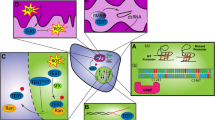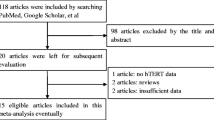Abstract
The continuous advancements in cancer research have contributed to the overwhelming evidence of the presence of telomerase in primary and secondary tumours together with hsp90 and c-Myc. This review will discuss the important role of telomerase together with hsp90 and c-Myc within the initiation and progression of gliomas. Also it will review the differential expression of these genes in the different grades of gliomas and the possibility of new treatments targeting these specific genes.
Similar content being viewed by others
References
Darling J: In Vitro Culture of Malignant Brain Tumors. In R. Pfragner, I. Freshney (eds). Culture of Human Tumor Cells Wiley-Liss, Inc. Verlag GmbH 2003, (pp 349–372)
Cooper N: Cancer Survival: England and Wales. Office for National Statistics 2004
Behin A, Hoang-Xuan K, Carpentier A, Delattre J: Primary brain tumours in adults. The Lancet 361: 323–331, 2003
Maher E, Furnari F, Bachoo R, Rowitch D, Louis D, Cavenee W, DePinho R: Malignant glioma: genetics and biology of a grave matter. Genes Dev 15: 1311–1333, 2001
Kleihues P, Cavenee K: Pathology and genetics of tumour of the nervous system. In FA Tavassoli and P Devilee (eds). Classification of Tumours. International Agency for Research on Cancer (IARC), World Health Organization (WHO), IARC Press: Lyon. 2000 (pp. 172–174)
Wessels P, Weber W, Raven G, Ramaekers F, Hopman A, Twijnstra A: Supratentorial grade II astrocytoma: biological features and clinical course. The Lancet 2: 395–403, 2003
Guo D: The identification and characterisation of LRIG gene family and its expression in astrocytic tumours. Umea University medical dissertations, 2004
Shiraishi S, Tada K, Nakamura H, Makino K, Kochi M, Saya H, Kuratsu J, Ushio Y: Influence of p53 mutations on prognosis of patients with glioblastoma. Cancer 95: 249–257, 2002
Castro M, Cowen R, Williamson I., David A, Jimenez-Dalmaroni M, Yuan X, Bigliari A, Williams J, Lowenstein P: Current and future strategies for the treatment of malignant brain tumours. Pharm Therap 98: 71–108, 2003
Louis D, Cavenee W: Cancer: V. DeVita, S. Hellman, S. Rosenberg (eds). Principles and Practice of Oncology. Lippincott-Raven, Philadelphia, 1997 (pp. 2013–2021)
Lang FF, Miller DC, Koslow M: Pathways leading to glioblastoma multiforme: a molecular analysis of genetic alterations in 65 astrocytic tumors. J Neurosurg 81: 427–436, 1994
Tremont-Lukats I, Gilbert M: Advances in molecular therapies in patients with brain tumors Cancer Control 10: 125–138, 2003
Smogorzewska A, Steensel B, Bianchi A, Oelmann S, Schaefer M, Shnapp G, Lange T. Control of human telomere length by TRF1 & TRF2. Mol Cell Biol 20: 1659–1668, 2000
Mergny J, Riou J, Mailliet P, Teulade-Fichou M, Gilson E: Natural and pharmacological regulation of telomerase. Nucleic Acids Research 30: 839–865, 2002
Sharpless N, DePinho R: Telomeres, stem cells, senescence and cancer. J Clin Invest 113: 160–168, 2004
Masutomi K, Hahn W: Telomerase and tumorigenesis. Cancer letters 194: 163–172, 2003
Ahmed A., Tollefsbol T: Telomeres, telomerase, and telomerase inhibition: clinical implications for cancer. J American Geriatrics Society 51: 116–122, 2003
Chang J, Chen Y, Yang H, Chen C, Cheng A: Differential regulation of telomerase activity by six telomerase subunits. Eur J Biochem 269: 3442–3450, 2002
Siyuan L, Zhu JJ, Anthony DC, Greider CW, Black PM: Telomerase activity in human gliomas. Neurosurg 42: 1120–1121, 1998
Harada K, kurisu K, Tahara H, Tahara E, Ide T, Tahara E: Telomerase activity in primary and secondary glioblastomas multiforms as a novel molecular tumour marker. J Neurosurg 93: 618–625, 2000
Reddle R, Bearss D, Hurley L: Telomeres and telomerase as drug targets. Current Opinion in Pharmacology 2: 415–423, 2002
Höhfeld J, Cyr D, Patterson C: From the cradle to the grave: molecular chaperones that may choose between folding and degradation. EMBO Reports 2: 885–890, 2001
Pockley G: Heat shock proteins in health and disease: therapeutic targets or therapeutic agents? Expert reviews in molecular medicine 2001: 1–20. 2001
Anderson KM., Srivastava PK: Heat, heat shock, heat shock proteins and death: a central link in innate and adaptive immune responses. Immunology Letters 74: 35–39, 2000
Buchner JS. Mayr BC, Jakob U: Purification and characterisation of prokaryotic and eukaryotic Hsp90. Methods of Enzymology 290: 409–418, 1998
Pratt W. Galigniana MD, Harrell JM, DeFranco DB: Role of Hsp90 and the Hsp90-binding immunophilins in signalling protein movement. Cellular Signalling 16: 857–872, 2004
Pratt W, Toft D: Regulation of signaling protein function and trafficking by the hsp90/hsp70-based chaperone machinery. Experimental Biology and Medicine 228: 111–133, 2003
Weikl T, Buchner J, Bügl H, Pirkl F, Bose S: Purification of Hsp90 partner proteins Hop/p60, p23, and FKBP52. Methods of Enzymology 290: 418- 429, 1998
Sreedhar A, Csermely P: Heat shock proteins in the regulation of apoptosis: new strategies in tumour therapy. Pharmacology and therapeutics 101: 227–257, 2004
Chiosis G, Vilenchik M, Kim J, Solit D: Hsp90: the vulnerable chaperone. Drug Discov Today 9: 881–888, 2004
Schulte T, Blagosklonny M, Ingui C, Neckers L: Disruption of the Raf-1-Hsp90 molecular complex results in destabilization of Raf-1 and loss of Raf-1-Ras association. J Biol Chem 270: 24585–24588, 1995
Yang J, Yang M, Iannone M, Shih WJ, Lin Y, Hait WN: Disruption of the EF-2 Kinase/Hsp90 protein complex: a possible mechanism to inhibit glioblastoma by geldanamycin. Cancer Research 61: 4010–4016, 2001
Nomura M, Nomura N, Newcomb EW, Lukyanov Y, Tamasdan C, Zagzag D: Geldanamycin induces mitotic catastrophe and subsequent apoptosis in human glioma cells. J Cell Physiol 201: 374–384, 2004
Lavictoire SJ, Parolin DA, Klimowicz AC, Kelly JF, Lorimer I.A: Interaction of Hsp90 with the Nascent Form of the Mutant Epidermal Growth Factor Receptor EGFRvIII. J Biol Chem 278: 5292–5299, 2002
Haendeler J, Hoffmann J, Rahman S, Zeiher AM, Dimmeler S: Regulation of Telomerase activity and anti-apoptotic function by protein-protein interaction and phosphorylation. Federation of European Biochemical Societies 536: 180–186, 2003
Roninson I: Oncogenic functions of tumour suppressor p21Waf1/Cip1/Sdi1: association with cell senescence and tumour-promoting activities of stromal fibroblasts. Cancer Letters 179: 11–14, 2002
Helt C, Staversky R, Lee Y, Bambara R, Keng P, O'Reilly M: The Cdk and PCNA domains on p21Cip1 both function to inhibit G1/S progression during hyperoxia. Am J. Physiol Lung Cell Mol Physiol 286: 506–513, 2004
Kanzawa T, Germano I, Kondo Y, Ito H, Kyo S, Kondo S: Inhibition of telomerase activity in malignant glioma cell lines correlates with their sensitivity to TMZ. Br J Cancer 89: 22–29, 2003
Zörnig M, Evan G: Cell cycle: on target with Myc. Current Biology. 6: 1553–1556, 1996
Levens D: Reconstructing MYC. Genes Development 17: 1071–1077, 2003
Packham G, Cleveland J: c-Myc and apoptosis. Biochimica et Biophysica Acta 1242: 11–28, 1995
Lavigne P, Crump MP, Gagné S, Hodges R, Kay C, Sykes B: Insights into the mechanism of heterodimerization from the H-NMR solution structure of the c-Myc/Max heterodimeric leucine zipper. J Mol Biol 281: 165–181, 1998
Pelengaris S, Khan M: The many faces of c-Myc. Arch Biochem Biophys. 416: 129–36, 2003
Dang C: C-Myc target genes involved in cell growth, apoptosis, and metabolism. Molecular and Cellular Biology 19: 1–11, 1999
Lutz W, Leon J, Eilers M: Contribution of Myc to tumorgenesis. Biochimica et Biophysica Acta 1602: 61–71, 2002
Oh S., Song Y, Kim U, Yim J, Kim T: In vivo and in vitro analyses of Myc for differential promoter activities of the human telomerase (hTERT) gene in normal and tumor cells. Biochem Biophys Res Commun 263: 361–365, 1999
Abba M., LaguensR., Dulout F., Golijow C: The c-myc activation in cervical carcinomas and HPV 16 infections. Mutation Research 557: 151–158, 2004
Sagawa Y, Nishi H, Isaka K, Fujito A, Takayama M: The correlation of TERT expression with c-Myc expression in cervical cancer. Cancer Letters 168: 45–50, 2001
Hsu C, Miaw J, Hsia J, Shai S, Chen C: Concordant expression of the telomerase-associated genes in non-small cell lung cancer. EJSO 29: 594–599, 2003
Zhang G, Gu Y, Zhao Z, Xu S, Zhang H, Wang H, Hao B: Coordinate increase of telomerase activity and c-Myc expression in Helicobacter pylori-associated gastric diseases. World J Gastroenterol 10: 1759–1762, 2004
Chrzan P, Skokowski J, Karmolinski A, Pawelczyk T: Amplification of c-myc gene and overexpression of c-Myc protein in breast cancer and adjacent non-neoplastic tissue. Clinical Biochemistry 34: 557–562, 2001
Pallini, R., Pierconti, F., Falchetti, M., D'Arcangelo, D., Fernandez, E., Maira, G., D'Ambrosio, E., Larocca, L. Evidence for telomerase involvement in the angiogenesis of astrocytic tumours: expression of human telomerase reverse transcriptase messenger RNA by vassculatr endothelial cells. J Neurosurg 94: 961–771, 2001
Chen C, Tsai N, Liu Y, Ho L, Hsieh H, Yen C, Harn H: Telomerase activity in human hepatocellular carcinoma: parallel correlation with human telomerase reverse transcriptase (hTERT) mRNA isoforms but not with cell cycle modulators or c-Myc expression. EJSO 28: 225–234, 2002
Herms J, von Loewenich F, Behnke J, Markakis E, Kretzschmar H: c-Myc oncogene family expression in glioblastoma and survival. Surg Neurol 51: 536–542, 1999
Huang H., Colella S, Kurrer M, Yonekawn Y, Kleihues P, Ohgaki H:. Gene expression profiling of low-grade diffuse astrocytomas by cDNA arrays. Cancer Research 60: 6868–6874, 2000
Kiaris H, Schally A: Decrease in telomerase activity in U-87MG human glioblastomas after treatment with an antagonist of growth hormone-releasing hormone. Proc Natl Acad Sci USA 96: 226–231, 1999
Miracco C, De Santi M, Luzi P, Lalinga A, Laurini L, De Nisi M, Angeloni G, Brogi M, Cardone C, Carducci A., Arcuri F, Tosi P, Rubino G, Pirtoli L: In situ detection of telomeres by fluorescence in situ hybridization and telomerase activity in glioblastoma multiforme: correlation with p53 status, EGFR, c-Myc, M1B1 and topoisomerase IIa protein expression. Int J Oncology 23: 1529–1535, 2003
Hau PU, Baumgart K, Pfeifer A. BockT, Jauch J, Dietrich K, Fabel O, Grauer C, Wismeth M, Klinkhammer-Schalke M, Allgäuer G, Schierer H, Koch J, Schlaier W, Ulrich A, Brawanski U, Bogdahn A, Steinbrecher: Salvage therapy in patients with glioblastoma; is there any benefit? Cancer 98: 2678–2686, 2003
Quinn M, Babb P, Brock A, Kirby L, Jones J: Cancer trends in England and Wales, 1950–1999. Studies on Medical and Population Subjects No. 66. London. The Stationery Office.
White I, Wright W, Shay J: Telomerase inhibitors. Trends Biotechnol 59: 114–120, 2001
Natarajan S, Chen N, Wancewicz E, Monia P, Corey D: Oligonucleotide. 14: 263–273, 2004
Kondo Y, Komata T, Kondo S: Combination therapy of 2–5A antisense telomerase RNA and ciplatin for malignant glioma. Int J Oncol 18: 1287–1292, 2001
Mukai S, Kondo Y, Koga S, Komata T, Barna B, Kondo S: 2–5A antisense telomerase RNA therapy for intracranial malignant gliomas. Cancer Research 60: 4461–4467, 2000
Kelland L: Telomerase inhibitors: targeting the vulnerable end of cancer. Anticancer Drugs 11: 503–513, 2000
Odago F, Gerson S: Telomerase inhibition and telomere erosion: a two-pronged strategy in cancer therapy. Trends in Pharmacological Sciences 24: 328–331, 2003
Holt S, Aisner D, Baur J, Tesmer V, Dy M, Ouellette M, Trager J, Morin G, Tort D, Shay J, Wright W, White M: Functional requirements of p23 and hsp90 in telomerase complexes. Genes Dev 13: 817–826, 1999
Kamal AM, Boehm F, Burrows FJ: Therapeutic and diagnostic implications of Hsp90 activation. Trends in Molecular Medicine 10: 283–290, 2004
Author information
Authors and Affiliations
Corresponding author
Rights and permissions
About this article
Cite this article
Shervington, A., Cruickshanks, N., Wright, H. et al. Glioma: What is the role of c-Myc, hsp90 and telomerase?. Mol Cell Biochem 283, 1–9 (2006). https://doi.org/10.1007/s11010-006-2495-z
Received:
Accepted:
Issue Date:
DOI: https://doi.org/10.1007/s11010-006-2495-z




